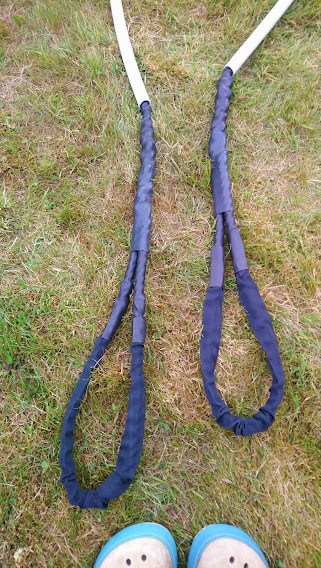We are carrying out acoustic monitoring for the next three months in Shetland. The sound recorders are attached to the Soldian Rock and Inner Voder cardinal buoys (photos and map below), which the Northern Lighthouse Board has kindly given us their permission to use for this study. As well as killer whale and harbour seal vocalizations, the hydrophones can detect other marine mammal species, such as Risso’s dolphins, and monitor background noise levels (sampling at 96 kHz). To last the whole deployment, the recorder is set to sleep for 10 min every 20 minutes.
The top-most mooring ropes are attached to two rings on top of the buoy and as such are visible to passers-by. If you happen to spot the attachments, please let us know, as it is always nice to hear they are safe and sound. Any nearby marine mammal sightings would also help the analysis of the recordings; the Inner Voder buoy is visible from South Nesting, and the Soldian Rock can be seen from Eswick, for example. To help estimate how far the recorders are from sightings and different vantage points, we have included distance buffers (1, 2 and 3 km) around each recorder in the map below. Pease feel free to get in touch – our email is ecopreds@st-andrews.ac.uk.
Huge thanks to Marine Scotland Science for their support and recorder loan, Phil Harris (Shetland Seabird Tours) and Richard Shucksmith for helping to make the deployment a success, Loggerhead Instruments for advice on the setup, and Karen Hall (NatureScot) for advice on siting the recorders. Kudos to Steven Balfour (SMRU Instrumentation) and Simon Moss (SMRU) for engineering the robust attachment system and weighted logger housing, without which this work would not be possible.



Photos below show the acoustic logger and hydrophone placed in the protective weighted housing. A large part of the logger is taken up by the batteries (24 D-cells!).



There are a few design aspects to the attachment. First, shackles and other metal parts are not used to avoid any clinking noise that could be picked up by the recorder, and any hard parts that could affect the cardinal buoy. The yellow sleeves further protect the buoy, while the tubing aims to eliminate chance of entanglement. The tubing, heatshrinks and webbing all protect the rope from wear & tear.





